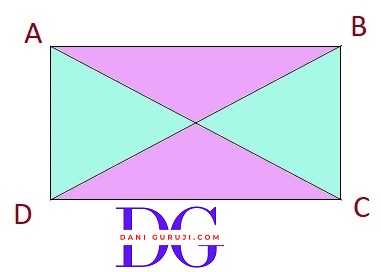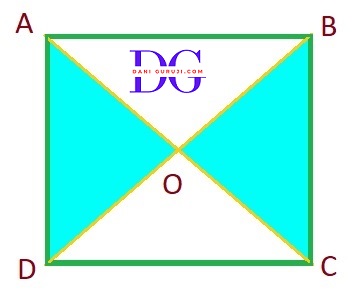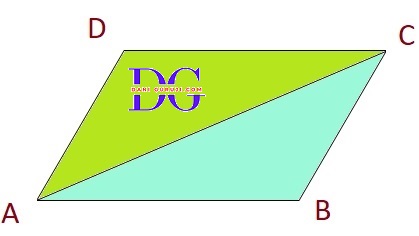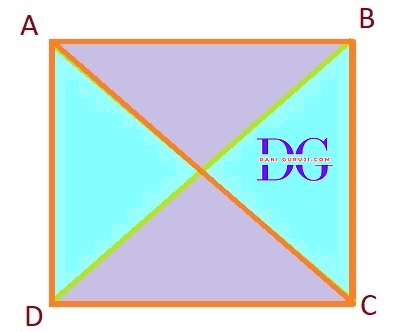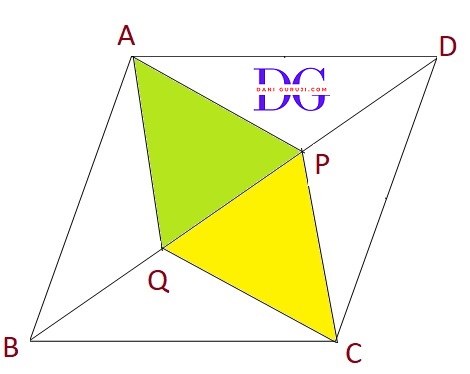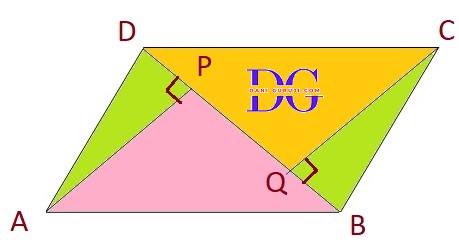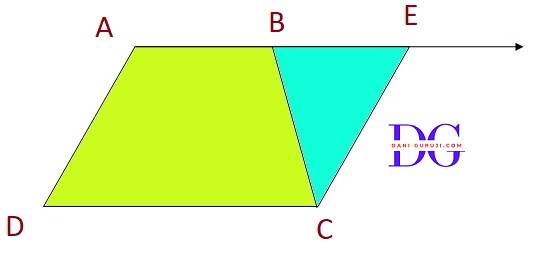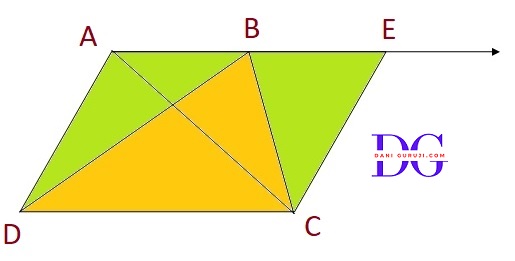If the diagonals of a parallelogram are equal, then show that it is a rectangle.
Solution :
Let's start with a parallelogram, ABCD . It has two diagonals, AC and BD. We are given that these two diagonals are equal in length AC = BD.
And also given that,
AD = BC and AB = CD (in parallelogram opposite side are equal)
To Prove:
We've shown it's a rectangle, means it's one angle is 90° .
Consider the Δ ABC and Δ ABD:
⇒ BC = AD
( In any parallelogram, opposite sides are equal, )
⇒ AC = BD
( Given, diagonals are equal. )
AB = AB
( This is a common side for both triangles.)
∴ Δ ABC $\cong$ Δ ABD
( by the SSS congruence rule. )
Congruent triangles have equal angles
In part (i), we know that Δ ABC $\cong$ Δ ABD
This means that corresponding parts of congruent triangles are equal (CPCT).
Therefore, $\angle $ABC = $\angle $DAB.
Since $\angle $ABC , $\angle $DAB are a linear pair, their sum is 180°
$\angle $ABC + $\angle $DAB = 180°
2 $\angle $ABC = $ { 180° }$
( Since we've already shown that $\angle $ABC = $\angle $DAB.)
$\angle $ABC = $ { 180° \over 2}$
$\angle $ABC = $ { 90° }$
This shows that one of the angles of the parallelogram is a right angle.
A parallelogram with one right angle is, by definition, a rectangle.
Show that the diagonals of a square are equal and bisect each other at right angles.
Solution :
Let's, consider ABCD to be a squre and it's diagonals AC and BD intersect each other at point O.
To Prove:
AC = BD , AO = OC and $\angle $AOB = 90° .
Consider the Δ ABC and Δ DAB:
⇒ BC = AD
( all sides of a square are equal, )
⇒ $\angle $ABC = $\angle $DAB = 90°
( all angles of a square are right angles. )
AB = AB
( This is a common side for both triangles.)
∴ Δ ABC $\cong$ Δ DAB
( by the SAS congruence rule. )
We know that Δ ABC $\cong$ Δ DAB
This means that corresponding parts of congruent triangles are equal (CPCT).
Therefore, AC = BD.
Hence, the diagonals of a square are equal in length.
Diagonals Bisect Each Other
Consider the Δ OAD and Δ OCB:
⇒ $\angle $OAD = $\angle $OCB
( Alternate angles are equal. )
⇒ BC = AD
( all sides of a square are equal, )
⇒ $\angle $ODA = $\angle $OBC
( Alternate angles are equal. )
∴ Δ OAD $\cong$ Δ OCB
( by the ASA congruence rule. )
We know that Δ OAD $\cong$ Δ OCB
This means that corresponding parts of congruent triangles are equal (CPCT).
Therefore, OA = OC and OB = OD.
Diagonals Bisect at Right Angles :
Consider the Δ AOB and Δ COB:
⇒ OA = OC
( As we had proved that diagonals bisect each other, )
⇒ BC = AB
( all sides of a square are equal, )
⇒ BO = OB
( This is a common side for both triangles. )
∴ Δ AOB $\cong$ Δ COB
( by the SSS congruence rule. )
We know that Δ AOB $\cong$ Δ COB
This means that corresponding parts of congruent triangles are equal (CPCT). Since the triangles are congruent, their corresponding angles are equal.
Therefore, $\angle $AOB = $\angle $COB.
Since $\angle $AOB , $\angle $COB form a linear pair, which means they are supplementary and add up to 180° .
$\angle $AOB + $\angle $COB = 180°
2 $\angle $AOB = $ { 180° }$
( Since we've already shown that $\angle $AOB = $\angle $COB.)
$\angle $AOB = $ { 180° \over 2}$
$\angle $AOB = $ { 90° }$
This proves that the diagonals of a square bisect each other at a right angle.
Diagonal AC of a parallelogram ABCD bisects $\angle $A (see Fig.). Show that
(i) it bisects $\angle $C also,
(ii) ABCD is a rhombus.
Solution :
Let's start with a parallelogram, ABCD .
We're given that diagonal AC bisects $\angle $A. means
$\angle $BAC= $\angle $DAC.----------equation (1)
AD = BC and AB = CD (in parallelogram opposite side are equal and parallel )
To Prove:
AC bisects $\angle $C .
(i): AC bisects $\angle $C
When a transversal line AC intersects two parallel lines AB and DC,
⇒ $\angle $BAC = $\angle $DCA ------ equation (2)
( the alternate interior angles are equal. )
Substituting the value from equation (1)
⇒ $\angle $DAC = $\angle $DCA --------- equation (3)
Similarly, AD is parallel to BC a transversal line AC intersects them,
⇒ $\angle $DAC = $\angle $BCA ----------equation (4)
( the alternate interior angles are equal. )
By combining the results from equation 3 and 4
⇒ $\angle $DCA = $\angle $BCA.
This shows that diagonal AC divides $\angle $ C into two equal angles,
which means it bisects $\angle $C.
(ii) ABCD is a rhombus.
Consider the Δ ABC:
In part (i), we proved that
$\angle $DCA = $\angle $BCA
Also, from equation 2 in part (i), we know that
⇒ $\angle $BAC = $\angle $DCA
Combining these two, we get
⇒ $\angle $BAC = $\angle $BCA.
In any triangle, if two angles are equal, the sides opposite to those angles are also equal.
Therefore, ⇒ AB = BC
In a parallelogram, opposite sides are equal, so we know that
AD = BC and AB = CD
Since we've proven AB = BC
It follows that AB = BC = CD = DA.
A parallelogram with all four sides equal is, by definition, a rhombus.
ABCD is a rectangle in which diagonal AC bisects ∠A as well as ∠C. Show that :
(i) ABCD is a square,
(ii)diagonal BD bisects $\angle $B as well as $\angle $D.
Solution :
In rectangle ABCD, we have:
AB || CD and AD || BC.
A rectangle is a parallelogram with all angles equal to 90°.
All angles ( $\angle $A, $\angle $B, $\angle $C, $\angle $D) are 90°.
We're given that diagonal AC bisects $\angle $A , $\angle $C. means
Since AC bisects $\angle $A, we have:
$\angle $BAC = $\angle $DAC = 90°/2 = 45°
(i): ABCD is a Square
Consider the Δ ABC:
So, in ΔABC, we have:
$\angle $BAC + $\angle $B + $\angle $BCA = 180°
( The sum of angles in a triangle is 180° )
45° + 90° + $\angle $BCA = 180°
⇒ $\angle $BCA = 180° - 135°
⇒ $\angle $BCA = 45°
Since $\angle $BCA = 45° = $\angle $BAC
In any triangle, if two angles are equal, the sides opposite to those angles are also equal.
Therefore, ⇒ AB = BC
Since ABCD is a rectangle, we know that opposite sides are equal.
AD = BC and AB = CD
Since we've proven AB = BC
Combining these facts, we have: AB = BC = CD = DA.
A rectangle with all sides equal is a square. Thus, ABCD is a square.
(ii): Diagonal BD bisects $\angle $B as well as $\angle $D
Consider the square ABCD and diagonal BD.
So, in ΔABD, we have:
AB = AD
( Since all sides of a square are equal )
⇒ $\angle $ ADB = $\angle $ ABD
( the angles opposite to equal sides must also be equal. )
In a square, all angles are 90°
In ΔABD, we have:
$\angle $BAD + $\angle $ABD + $\angle $ADB = 180°
( The sum of angles in a triangle is 180° )
⇒ 90° + $\angle $ABD + $\angle $ADB = 180°
⇒ 90° + $\angle $ABD + $\angle $ABD = 180°
( Proved above, $\angle $ ADB = $\angle $ ABD )
⇒ 90° + 2$\angle $ABD = 180°
⇒ 2$\angle $ABD = 180° - 90°
⇒ 2$\angle $ABD = 90°
⇒ $\angle $ABD = 45°
$\angle $ ADB = $\angle $ ABD = 45°
This means that diagonal BD divides the 90° angle $\angle $B into two 45° angles
( $\angle $ABD = 45° and $\angle $DBC = 45° ) and the 90° angle $\angle $D into two 45° angles ($\angle $ADB = 45° and $\angle $CDB = 45° ).
Therefore, diagonal BD bisects both $\angle $B and $\angle $D.
In parallelogram ABCD, two points P and Q are taken on diagonal BD such that DP = BQ (see Fig.) Show that:
(i) Δ APD $\cong$ Δ CQB
(ii) AP = CQ
(iii) Δ AQB $\cong$ Δ CPD
(iv) AQ = CP
(v) APCQ is a parallelogram
Solution :
(i): Δ APD $\cong$ Δ CQB
So, in Δ APD and Δ CQB we have:
AD = BC
( Opposite sides of a parallelogram are equal. )
⇒ $\angle $ ADP = $\angle $ CBQ
( These are alternate interior angles, as AD is parallel to BC (opposite sides of a parallelogram) and BD is the transversal. )
DP = BQ
( This is given in the problem statement. )
Since we have two sides and the included angle equal, we can conclude that, by Side-Angle-Side (SAS) congruence criterion :
Δ APD $\cong$ Δ CQB
(ii) Proving AP = CQ
We've just proven that Δ APD $\cong$ Δ CQB . Since the triangles are congruent, We know that, Corresponding parts of congruent triangles are equal. Therefore,
⇒ AP = CQ
(iii) Δ AQB $\cong$ Δ CPD
So, in Δ AQB and Δ CPD we have:
AB = CD
( Opposite sides of a parallelogram are equal. )
⇒ $\angle $ ABQ = $\angle $ CDP
( These are alternate interior angles, as AB is parallel to DC and BD is the transversal. )
DP = BQ
( This is given in the problem statement. )
Since we have two sides and the included angle equal, we can conclude that, by Side-Angle-Side (SAS) congruence criterion :
Δ AQB $\cong$ Δ CPD
(iv) Proving AQ = CP
We've just proven that Δ AQB $\cong$ Δ CPD . Since the triangles are congruent, We know that, Corresponding parts of congruent triangles are equal. Therefore,
⇒ AQ = CP
(v) Proving APCQ is a parallelogram
A quadrilateral is a parallelogram if its opposite sides are equal.
⇒ AQ = CP
( This is proved above in part (iv))
⇒ AP = CQ
( This is proved above in part (ii))
Since both pairs of opposite sides are equal, the quadrilateral APCQ is a parallelogram.
ABCD is a parallelogram and AP and CQ are perpendiculars from vertices A and C on diagonal BD. Show that
(i) Δ APB $\cong$ Δ CQD
(ii) AP = CQ
Solution :
(i): Δ APB $\cong$ Δ CQD
So, in Δ APB and Δ CQD we have:
AB = CD
( The opposite sides of a parallelogram are equal in length. )
⇒ $\angle $ ABP = $\angle $CDQ
( These are alternate interior angles, as AD is parallel to BC (opposite sides of a parallelogram) and BD is the transversal. )
$\angle $APB = $\angle $CQD
( Both are right angles, as AP and CQ are perpendiculars to the diagonal BD )
Since we have two corresponding angles and a non-included side equal, we can conclude that, by Angle-Angle-Side (AAS) congruence criterion :
Δ APB $\cong$ Δ CQD
(ii) Proving AP = CQ
We've just proven that Δ APB $\cong$ Δ CQD . Since the triangles are congruent, We know that, Corresponding parts of congruent triangles are equal. Therefore,
⇒ AP = CQ
ABCD is a trapezium in which AB || CD and AD = BC. Show that:
(i) $\angle $A = $\angle $B
(ii) $\angle $C = $\angle $D
(iii) Δ ABC $\cong$ Δ BAD
(iv) diagonal AC = diagonal BD
Solution :
(i) $\angle $A = $\angle $B
We first need to do a small construction. Extend side AB and draw a line CE parallel to AD, intersecting the extended AB at point E.:
AD = CE
( Since AD || CE and AE is a transversal, ADCE is a parallelogram by construction. The opposite sides of a parallelogram are equal in length. )
⇒ AD = BC
( given )
Therefore, from above
∴ BC = CE
Consider the Δ BCE:
So, in Δ BCE, we have BC = CE, it is an isosceles triangle, which means
$\angle $CBE = $\angle $CEB ----- Equc.(1)
$\angle $ABC + $\angle $CBE = 180° ----- Equc.(2)
( Because these angles form a linear pair )
Consider, parallel lines AD and CE where AE is the transversal.
We know that consecutive interior angles are supplementary, so
$\angle $A + $\angle $AEC = 180°
$\angle $A + $\angle $CEB = 180° ----- Equc.(3)
( $\angle $AEC = $\angle $CEB, because they are the same angle )
From Equc.(2) and Equc.(3), we have
$\angle $ABC + $\angle $CBE = $\angle $A + $\angle $CEB
Since $\angle $CBE = $\angle $CEB ,
We can subtract them from both sides, which gives us
$\angle $ABC = $\angle $A
Thus, $\angle $A = $\angle $B.
(ii) $\angle $C = $\angle $D
From figure,
AB || CD
We know that the consecutive interior angles are supplementary
$\angle $A + $\angle $D = 180°
$\angle $B + $\angle $C = 180°
From part (i), we know that
$\angle $A = $\angle $B
Substituting Values of $\angle $A
$\angle $B + $\angle $D = 180°
$\angle $B + $\angle $C = 180°
By comparing these two equations, we can conclude that
$\angle $C = $\angle $D
(iii) Δ ABC $\cong$ Δ BAD
So, in Δ ABC and Δ BAD we have:
AB = AB
( This is a common side to both triangles. )
⇒ $\angle $ A = $\angle $B
( Proved in part (i) )
BC = AD
( This is given )
Since two sides and the included angle are equal, we can conclude that,
ΔABC $\cong$ Δ BAD
(iv) Proving diagonal AC = diagonal BD
We've just proven that ΔABC $\cong$ Δ BAD . Since the triangles are congruent, We know that, Corresponding parts of congruent triangles are equal. Therefore,
⇒ AC = BD
Syllabus for class 10
Advanced courses and exam preparation.
Previous Year Paper
Advanced courses and exam preparation.
Mock Test
Explore programming, data science, and AI.
